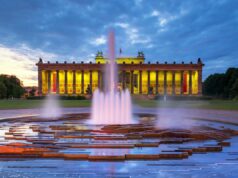
As it is usual in modern democratic states, the German government is structured according to the principle of the separation of powers which is enshrined in the constitution. As a matter of fact, the structure of the German government is, to some extent, modeled upon that of the US. This is due to the fact that the military control of the Allied Forces instructed and supervised the process of drafting a constitution for post-war Germany. So, what does the political system look like?
The Federal President
The head of state in Germany is the Federal President. Although it is the highest office, the president is neither in a practical nor a legal sense part of the German Government. The role is primarily and almost entirely a representative one, and the president is expected to be a neutral figure who is above everyday politics.
The most important tasks of the Federal President is to appoint and to dismiss the members of the German government. The president suggests a candidate for the parliament to elect as chancellor, appoints the ministers of the cabinet, and conducts the inauguration. The holder of the office also dismisses the ministers if they wish to resign or on the occasion of a request for a dismissals from the chancellor. The president also has to sign the laws passed by the parliament in order for them to become effective.
The Federal President of Germany resides at Schloss Bellevue in Berlin. A term of office lasts five years, and a re-election is only allowed once. The Federal Assembly which has to elect the president consists of the members of the parliament and an equal number of representatives that the parliaments of the 16 States elect. It is not uncommon for the States to send prominent figures, such as sport stars or musicians.
The legislative branch of the German government
The legislative branch of the German government consists of two chambers, the Bundestag, and the Bundesrat.
The Bundestag
The Bundestag is the main body of the legislative branch of the German government. It currently has 736 members. With a few exceptions, almost everyone is a member of one of six political parties. The parliament’s function is to enact legislation and to elect and control the government. In order to fulfill its function, the parliament holds members of the government accountable in a weekly questioning hour. Apart from this regular procedure, it also has the right to summon any member of the government to attend a session of the parliament.
The Parliament convenes in the Reichstag in the heart of Berlin. The building is open to visitors – make sure no to miss it! Elections for the parliament take place every four years, with the last one in 2021. However, it is possible for the Federal President to dissolve the parliament and initiate new elections if the chancellor fails a vote of confidence. The last time this happened was in 2005 which led to Angela Merkel becoming the successor of Gerhard Schröder.
The Bundesrat
The smaller and lesser known legislative chamber in the German political structure is the Bundesrat. Its function is to represent the 16 States on a federal level. It has 69 members who are appointed by the governments of the States. Representatives in the Bundesrat have to vote according to the orders from the respective government.
The Bundesrat fulfills its function by voting on laws that the parliament proposes. Not every law requires a vote from both chambers, though. If a proposed law concerns a topic as defined in the constitution, the Bundesrat has to vote on it. There is no regular term of office for members of the Bundesrat. Rather, its members change as the governments of the States change. The head of the Bundesrat also serves as deputy Federal President. This briefly became relevant in 2010, when Horst Köhler was the first president to voluntarily resign before his term of office ended.
The Federal Government of Germany
The Government is the executive branch in the German political system. Its members are the chancellor and the ministers. The constitution endows the chancellor with the right to define the guiding principles of politics. These guiding principles establish the framework within which the ministers can execute their competence. The government mainly acts by drafting laws and proposing them to the parliament. The chancellor resides at the Bundeskanzleramt, not far from the Reichstag. The term of office for the chancellor and the ministers usually coincides with the terms of office of the parliament. The current government that came into office after the 2021 elections is the first one to consist of members of three different parties.
The Federal Courts
Although regular jurisdiction is in the hands of the states, there are number of federal supreme courts that make up the judicative branch of the German government. They are specialized with regard to specific domains of the law: labour, social, finance, and administrative. Furthermore, there is the Federal Court of Appeal for matters on criminal and civil law, and the Federal Constitutional Court. The last one does not count as a regular appellate court (in contrast to, for instance, the United States Supreme Court). Its responsibility is the juridical review of laws and decisions of minor courts. It also possesses the power to ban political parties if it finds their agenda to be inimical to the principles of democracy and the rule of law. In over 70 years, it has executed this power twice.
The Federal Supreme Courts reside in various cities in Germany, with none of them being set in Berlin. The Federal Constitutional Court is located in Karlsruhe, just north of the Black Forest. Judges are elected by a committee of members of the parliament and the Bundesrat. Their term of office lasts twelve years and a re-election is impossible.
A carefully crafted constitution
Given the history of disruptions that Germany experienced in the first half of the 20th century, a commitment to freedom, peace, and democracy is at the heart of its political structure. Modern Germany derives a substantial part of its national identity from the phrase “never again”. The design of the constitution reflects this fact and has a number of mechanisms in place to prevent another downfall into dictatorship and unrest. So far, it has succeeded in securing stability and prosperity for millions of citizens.
The German Government – FAQ
The head of state in Germany is the Federal President who is elected every five years. The office serves a mainly representative function.
The head of government is the Federal Chancellor. The chancellor is usually elected from the ranks of the parliament.
The President of Germany is the head of state. However, the office comes with a primarily representative function. The chancellor, on the other hand, is responsible for planning and enacting political measures.
Germany is a Federal Republic of 16 States. All state parliaments as well as the federal parliament are democratically elected. The constitution states that the government is committed to upholding the principles of democracy, rule of law, federation, and welfare.















